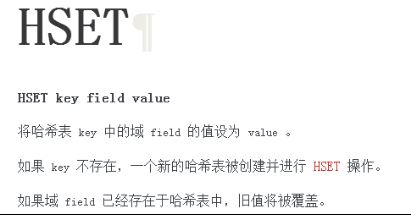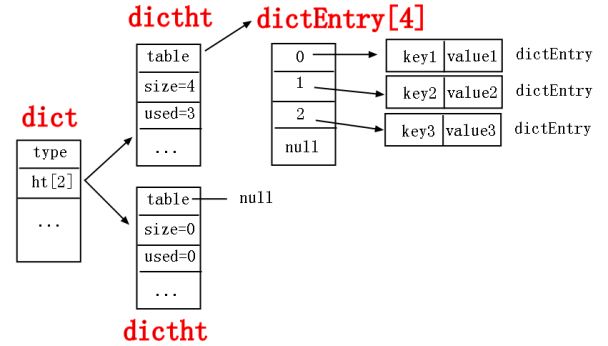redis中的hash也是我们使用中的高频数据结构,它的构造基本上和编程语言中的HashTable,Dictionary大同小异,如果大家往后有什么逻辑需要用Dictionary存放的话,可以根据场景优先考虑下redis哦。
一:常用方法
只要是一个数据结构,最基础的永远是CURD,redis中的insert和update,永远只需要set来替代,比如下面的Hset,如下图:

就好像Java中的类和方法,知道传递一些啥参数就OK了,就比如要说的HSet,它的格式如下:

接下来我在CentOS里面操作一下,
[administrator@localhost redis-3.0.5]$ src/redis-cli
.0.0.1:6379> clear
.0.0.1:6379> hset person name jack
(integer) 1
.0.0.1:6379> hset person age 20
(integer) 1
.0.0.1:6379> hset person sex famale
(integer) 1
.0.0.1:6379> hgetall person
) "name"
) "jack"
) "age"
) "20"
) "sex"
) "famale"
.0.0.1:6379> hkeys person
) "name"
) "age"
) "sex"
.0.0.1:6379> hvals person
) "jack"
) "20"
) "famale"
.0.0.1:6379>
或许有人看了上面的console有一点疑惑,那就是前面有几个参数,比如person,name啦,然后才是value,其实在redis的这个层面,它永远只有一个键,一个值,这个键永远都是字符串对象,也就是SDS对象,而值的种类就多了,有字符串对象,有队列对象,还有这篇的hash对象,往后的有序集合对象等等,如果你还不明白的话,转化为Java语言就是。
MapString,String> person=new HashMapstring,string>();
person.Add("name","jack");
....
调用方法就是这么的简单,关键在于时不时的需要你看一看手册,其实最重要的是了解下它在redis源码中的原理就好了。
二:探索原理
hash的源代码是在dict.h源代码里面,枚举如下:
typedef struct dictEntry {
void *key;
union {
void *val;
uint64_t u64;
int64_t s64;
double d;
} v;
struct dictEntry *next;
} dictEntry;
typedef struct dictType {
unsigned int (*hashFunction)(const void *key);
void *(*keyDup)(void *privdata, const void *key);
void *(*valDup)(void *privdata, const void *obj);
int (*keyCompare)(void *privdata, const void *key1, const void *key2);
void (*keyDestructor)(void *privdata, void *key);
void (*valDestructor)(void *privdata, void *obj);
} dictType;
/* This is our hash table structure. Every dictionary has two of this as we
* implement incremental rehashing, for the old to the new 0. */
typedef struct dictht {
dictEntry **table;
unsigned long size;
unsigned long sizemask;
unsigned long used;
} dictht;
typedef struct dict {
dictType *type;
void *privdata;
dictht ht[2];
long rehashidx; /* rehashing not in progress if rehashidx == -1 */
int iterators; /* number of iterators currently running */
} dict;
/* If safe is set to 1 this is a safe iterator, that means, you can call
* dictAdd, dictFind, and other functions against the dictionary even while
* iterating. Otherwise it is a non safe iterator, and only dictNext()
* should be called while iterating. */
typedef struct dictIterator {
dict *d;
long index;
int table, safe;
dictEntry *entry, *nextEntry;
/* unsafe iterator fingerprint for misuse detection. */
long long fingerprint;
} dictIterator;
上面就是我们使用hash的源代码数据结构,接下来我来撸一撸其中的逻辑关系。
dict结构
typedef struct dict {
dictType *type;
void *privdata;
dictht ht[2];
long rehashidx; /* rehashing not in progress if rehashidx == -1 */
int iterators; /* number of iterators currently running */
} dict;
这个结构是hash的真正的底层数据结构,可以看到其中有5个属性。
1> dictType *type
可以看到它的类型是dictType,从上面你也可以看到,它是有枚举结构定义的,如下:
typedef struct dictType {
unsigned int (*hashFunction)(const void *key);
void *(*keyDup)(void *privdata, const void *key);
void *(*valDup)(void *privdata, const void *obj);
int (*keyCompare)(void *privdata, const void *key1, const void *key2);
void (*keyDestructor)(void *privdata, void *key);
void (*valDestructor)(void *privdata, void *obj);
} dictType;
从上面这个数据结构中你可以看到里面都是一些方法,但是有一个非常重要的方法,那就是第一个hashFunction,可以看到它就是计算hash值的,跟Java中的求hash值差不多。
2> dictht ht[2]
你可能会疑问,为什么这个属性是2个大小的数组呢,其实正真使用的是ht[0],而ht[1]是用于扩容hash表时的暂存数组,这一点也很奇葩,同时也很精妙,redis为什么会这么做呢???仔细想想你可能会明白,扩容有两种方法,要么一次性扩容,要么渐进性扩容,后面这种扩容是什么意思呢?就是我在扩容的同时不影响前端的CURD,我慢慢的把数据从ht[0]转移到ht[1]中,同时rehashindex来记录转移的情况,当全部转移完成之后,将ht[1]改成ht[0]使用,就这么简单。
dicth结构
typedef struct dictht {
dictEntry **table;
unsigned long size;
unsigned long sizemask;
unsigned long used;
} dictht;
1> dictEntry **table;
从上面这个结构体中,你可以看到一个非常重要的属性: dictEntry **table, 其中table是一个数组,数组类型是dictEntry,既然是一个数组,那后面的三个属性就好理解了,size是数组的大小,sizemask和数组求模有关,used记录数组中已使用的大小,现在我们把注意力放在dictEntry这个数组实体类型上面。
dictEntry结构
typedef struct dictEntry {
void *key;
union {
void *val;
uint64_t u64;
int64_t s64;
double d;
} v;
struct dictEntry *next;
} dictEntry;
从这个数据结构上面你可以看到有三个大属性。
第一个就是: *key:它就是hash表中的key。
第二个就是: union的*val 就是hash的value。
第三个就是: *next就是为了防止hash冲突采用的挂链手段。
如果总结上面描述的话,我可以画出如下的hash结构图。

您可能感兴趣的文章:- redis哈希和集合_动力节点Java学院整理
- Redis中哈希分布不均匀的解决办法
 咨 询 客 服
咨 询 客 服